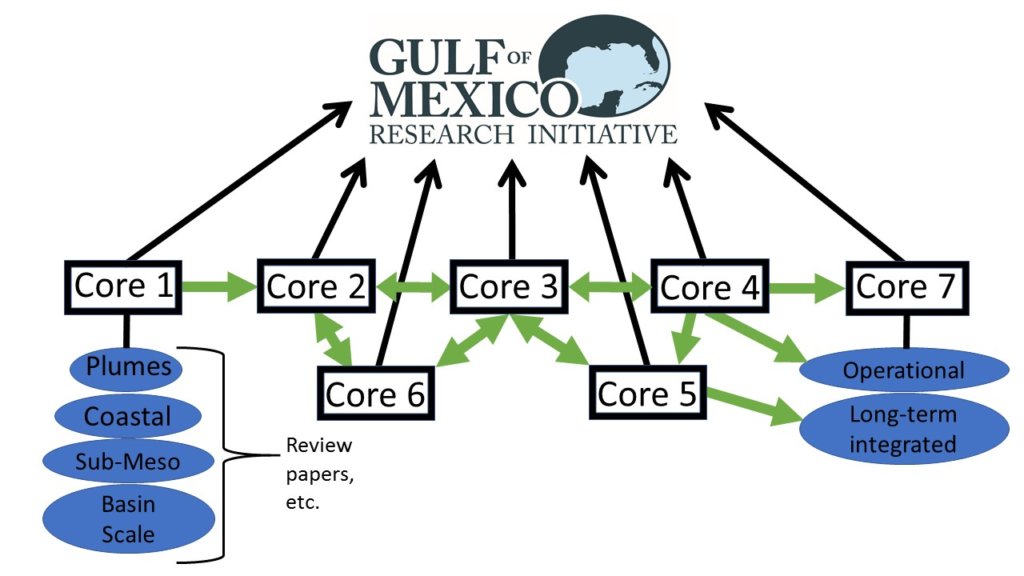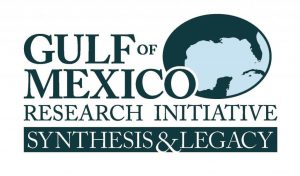GoMRI Synthesis and Legacy
GoMRI was established in 2010 with the stated goal to improve society’s ability to understand, respond to, and mitigate the impacts of petroleum pollution and related stressors of the marine and coastal ecosystems. As we approach 2020 and the conclusion of 10 years of GoMRI’s investment in research, the Research Board has shifted focus towards achieving comprehensive scientific synthesis centered around the answers to 5 key questions and establishing and cementing the GoMRI legacy. View products resulting from GoMRI’s Synthesis and Legacy efforts here!
5 Key Questions
- What was the state of the science (“baseline”) before Deepwater Horizon?
- What have we learned? (Critical assessment)
- What major gaps in knowledge still exist?
- How can we best apply what we have learned? (What will be the impact – how do we make a difference?)
- Where do we go from here?
Synthesis Objectives and Mission
The overarching goal of the GoMRI’s Synthesis effort is to document and exploit scientific achievements and advances, with the idea that synthesis will lead to new understanding and improved practices. This synthesis effort will be driven by the best available science, will include knowledge exchange with the user community, including oil spill responders, NGOs, restoration efforts, and other stakeholders, and will explore the transferability of knowledge to other geographic locations and scenarios.
GoMRI Synthesis consists of the convergence of two parallel efforts – the “top down” is INITIATED by the Research Board – but is DRIVEN by the science COMMUNITY. The “bottom up” is led and organized by the GoMRI Research Consortia, Individual Investigator teams, and the extensive network of experts each has established. Though a series of workshops and subsequent publications, special issues, and presentations, GoMRI expects to be able to answer the five key questions across each of eight identified Core Areas at the conclusion of the initiative.
8 Core Areas
The Research Board as been in the unique position to observe the evolution of GoMRI from the very beginning. To best capture a comprehensive top down scientific synthesis from the 10 years of GoMRI’s investment in research, a Synthesis and Legacy (S&L) committee was established and subsequently identified eight Core Areas of focus and a set of universal guiding principles to maintain consistency throughout this synthesis effort.
- Core Area 1 – Plume & Circulation Observations & Modeling
- Core Area 2 – Fate of Oil & Weathering: Biological & Physical-Chemical Degradation
- Core Area 3 – Ecological/Ecosystem Impacts
- Core Area 4 – Human Health and Socioeconomic Impacts
- Core Area 5 – Ecosystem Services, Human Health and Socioeconomic Impacts
- Core Area 6 – Microbiology, Metagenomics & Bioinformatics
- Core Area 7 – Integrated/Linked Modeling System
- Core Area 8 – Knowledge Exchange with User Communities: Lessons Learned and Operational Advice
While the first four Core Areas closely map the GoMRI research themes, Core Areas 5, 7, and 8 largely focus on how to apply research and knowledge gained to the operational and user communities. Core Area 6 was identified to synthesize and capture the multitude of advancements in Microbiology, Metagenomics, and Bioinformatics since GoMRI began.
This diagram illustrates the interrelated nature of the GoMRI Core Areas. The green arrows indicate critical lines of communication. Each Core Area has multiple subtopics, as shown here in the Core Area 1 example. The Core Area 8 advisory group will play a unique and crucial role throughout all the Core Areas promoting the effective application and communication of GoMRI funded science between the research and user communities. Products from the subtopics, designed for a scientific audience within that specific field, will help inform a product for each Core Area that is written for scientific audiences in all fields. Eventually, all Core Area products will inform synthesis products for the general public, part of which will be a special issue of Oceanography (click here to see a draft outline of that issue).
Legacy
The GoMRI Legacy Goals are meant to be achieved by the end of the program and include:
- Significantly advance the scientific understanding of the Gulf of Mexico, including its interactions with oil, dispersant, and dispersed oil by fostering the highest quality of research for the benefit of those who depend upon its ecosystems for their well-being.
- Engender improved understanding, confidence, and trust of the public and other stakeholders (e.g. business and industrial community, government, policy makers and managers/planners, media, K-12 educators, undergraduate and graduate students as future scientists, GoMRI research participants, and the national and international scientific community) and inform best science-based policy and management.
- Build intellectual capacity by: a) advancing relevant technologies; b) fostering research connectivity; c) building and maintaining an interactive GoMRI Gulf of Mexico database that can serve as a future baseline and to inform a more efficient future response; d) informing and training future scientists and engineers; and e) stimulating interest in STEM for K-12 students and educators.
- Demonstrate that the responsiveness of the GoMRI model is appropriate and effective in serving the public good by enabling and overseeing timely and independent research funded through a private-public partnership with industry.
Many additional Synthesis and Legacy questions can be answered by visiting the FAQ page.


